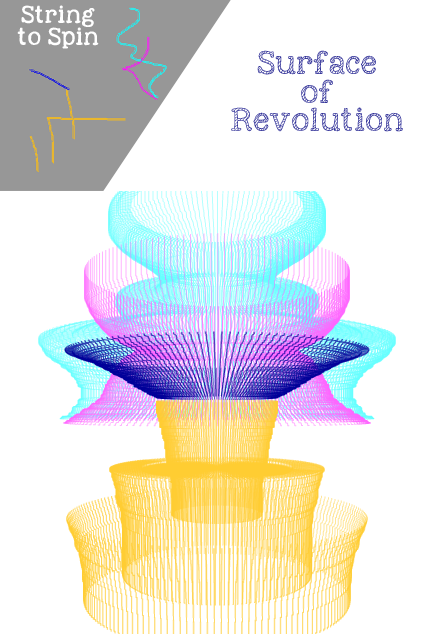Multiplication course, bodies of revolution, global news: Newsletter March 17, 2014
Subscribe to Moebius Noodles newsletters
Pinterest | Twitter | Facebook | Google+
I am Moby Snoodles, and this is my newsletter. Send me your requests, questions and comments at moby@moebiusnoodles.com

Math Spark: Bodies of Revolution
Math Sparks are quick activities for grown-ups. If this one sparks your curiosity, share it with kids too!
Calculus studies how big things are made of little things. You can make some surfaces out of infinitely many copies of the same line, rotated in space. The best way to define solids and surfaces of revolution is by describing how to make them. If you’ve worked with a wood lathe, a pottery wheel, or an ice cream scoop, you are already familiar with the idea.

Here’s how mathematicians might give a constructive definition of a solid of revolution:
1. Draw a straight line.
2. Start at one end of the line and draw a squiggle that ends at the other. Now you have a shape.
3. Rotate this shape around the straight line
For a surface of revolution, you don’t even need to connect your squiggle to the line of rotation. Try creating your own surface of revolution with String Spin: http://www.zefrank.com/string_spinv2/
Any squiggle, even a random toddler’s doodle, becomes interesting once you spin it.
Moebius Noodles in the global news
My interview by Luba Vangelova for The Atlantic, 5-Year-Olds Can Learn Calculus, has generated discussions on blogs, forums, and news sites. I feel very thankful for the thoughtfu comments and deep questions. The themes that emerge from discussions make me cautiously optimistic. Many grown-ups believe that young math will finally give them a second chance at making sense of algebra and calculus. Others look for the balance between conceptual understanding and fluency at manipulating numbers. Even if 5-year-olds understand calculus, what would they use it for? Can we even call activities algebra or calculus if there are no formulas? Are young kids capable of abstraction?
At the same time quite a few people have come out saying that they are already playing advanced math games with toddlers or young kids – or that their parents did so with them! Our Natural Math community will be following up on these themes with an open event series, interviewing parents, teachers, researchers, and project leaders who work in related areas.
Want to join the discussion? Send me a story about math adventures of your kids, your students, or someone you know. It can be a cute thing your three-year-old said, or a game your mom made up for you when you were little, or an activity you adapted for your math circle. I am making a collection of happy young math stories!
Natural Math Multiplication: an online course in April

We invite parents, teachers, playgroup hosts, and math circle leaders to join us in April for an open online course about multiplication. Each week there will be five activities to help your kids learn multiplication by exploring patterns and structure. To get your course completion badge, do at least two activities every week. The course starts April 6 and runs for four weeks.
Each activity will have adaptations for toddlers (2-4), young kids (4-6), and older kids (7-12). If you want to remix activities for babies or teens, we will help!
Click to join the course.
Here is the preliminary syllabus.
Week 1: Introduction. What is multiplication? Hidden dangers and precursors of math difficulties. From open play to patterns: make your own math. 60 ways to stay creative in math. Our mathematical worries and dreams.
Week 2: Inspired by calculus. Tree fractals. Substitution fractals. Multiplication towers. Doubling and halving games. Zoom and powers of the Universe.
Week 3: Inspired by algebra. Factorization diagrams. Mirror books and snowflakes. Combination and chimeras. Spirolaterals and Waldorf stars: drafting by the numbers. MathLexicon.
Week 4: Times tables. Coloring the monster table. Scavenger hunt: multiplication models and intrinsic facts. Cuisenaire, Montessori, and other arrays. The hidden and exotic patterns. Healthy memorizing.
Sharing
You are welcome to share the contents of this newsletter online or in print.
Talk to you soon! Moby Snoodles, aka Dr. Maria Droujkova
Related Posts
Posted in Newsletter















Leave a Reply